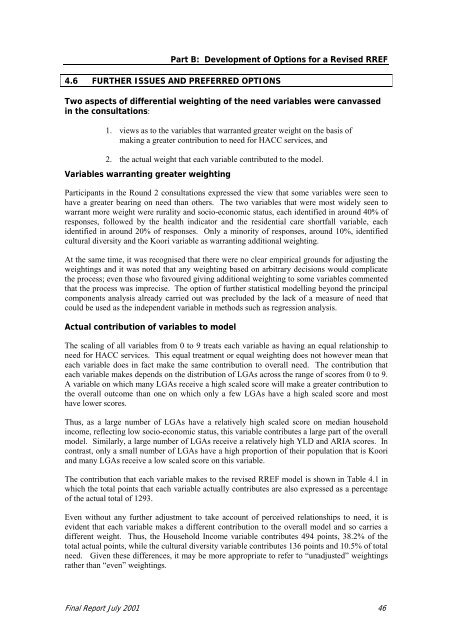Final Report on RREF 2001 - Department of Health
Final Report on RREF 2001 - Department of Health
Final Report on RREF 2001 - Department of Health
You also want an ePaper? Increase the reach of your titles
YUMPU automatically turns print PDFs into web optimized ePapers that Google loves.
Part B: Development <strong>of</strong> Opti<strong>on</strong>s for a Revised <strong>RREF</strong><br />
4.6 FURTHER ISSUES AND PREFERRED OPTIONS<br />
Two aspects <strong>of</strong> differential weighting <strong>of</strong> the need variables were canvassed<br />
in the c<strong>on</strong>sultati<strong>on</strong>s:<br />
1. views as to the variables that warranted greater weight <strong>on</strong> the basis <strong>of</strong><br />
making a greater c<strong>on</strong>tributi<strong>on</strong> to need for HACC services, and<br />
2. the actual weight that each variable c<strong>on</strong>tributed to the model.<br />
Variables warranting greater weighting<br />
Participants in the Round 2 c<strong>on</strong>sultati<strong>on</strong>s expressed the view that some variables were seen to<br />
have a greater bearing <strong>on</strong> need than others. The two variables that were most widely seen to<br />
warrant more weight were rurality and socio-ec<strong>on</strong>omic status, each identified in around 40% <strong>of</strong><br />
resp<strong>on</strong>ses, followed by the health indicator and the residential care shortfall variable, each<br />
identified in around 20% <strong>of</strong> resp<strong>on</strong>ses. Only a minority <strong>of</strong> resp<strong>on</strong>ses, around 10%, identified<br />
cultural diversity and the Koori variable as warranting additi<strong>on</strong>al weighting.<br />
At the same time, it was recognised that there were no clear empirical grounds for adjusting the<br />
weightings and it was noted that any weighting based <strong>on</strong> arbitrary decisi<strong>on</strong>s would complicate<br />
the process; even those who favoured giving additi<strong>on</strong>al weighting to some variables commented<br />
that the process was imprecise. The opti<strong>on</strong> <strong>of</strong> further statistical modelling bey<strong>on</strong>d the principal<br />
comp<strong>on</strong>ents analysis already carried out was precluded by the lack <strong>of</strong> a measure <strong>of</strong> need that<br />
could be used as the independent variable in methods such as regressi<strong>on</strong> analysis.<br />
Actual c<strong>on</strong>tributi<strong>on</strong> <strong>of</strong> variables to model<br />
The scaling <strong>of</strong> all variables from 0 to 9 treats each variable as having an equal relati<strong>on</strong>ship to<br />
need for HACC services. This equal treatment or equal weighting does not however mean that<br />
each variable does in fact make the same c<strong>on</strong>tributi<strong>on</strong> to overall need. The c<strong>on</strong>tributi<strong>on</strong> that<br />
each variable makes depends <strong>on</strong> the distributi<strong>on</strong> <strong>of</strong> LGAs across the range <strong>of</strong> scores from 0 to 9.<br />
A variable <strong>on</strong> which many LGAs receive a high scaled score will make a greater c<strong>on</strong>tributi<strong>on</strong> to<br />
the overall outcome than <strong>on</strong>e <strong>on</strong> which <strong>on</strong>ly a few LGAs have a high scaled score and most<br />
have lower scores.<br />
Thus, as a large number <strong>of</strong> LGAs have a relatively high scaled score <strong>on</strong> median household<br />
income, reflecting low socio-ec<strong>on</strong>omic status, this variable c<strong>on</strong>tributes a large part <strong>of</strong> the overall<br />
model. Similarly, a large number <strong>of</strong> LGAs receive a relatively high YLD and ARIA scores. In<br />
c<strong>on</strong>trast, <strong>on</strong>ly a small number <strong>of</strong> LGAs have a high proporti<strong>on</strong> <strong>of</strong> their populati<strong>on</strong> that is Koori<br />
and many LGAs receive a low scaled score <strong>on</strong> this variable.<br />
The c<strong>on</strong>tributi<strong>on</strong> that each variable makes to the revised <strong>RREF</strong> model is shown in Table 4.1 in<br />
which the total points that each variable actually c<strong>on</strong>tributes are also expressed as a percentage<br />
<strong>of</strong> the actual total <strong>of</strong> 1293.<br />
Even without any further adjustment to take account <strong>of</strong> perceived relati<strong>on</strong>ships to need, it is<br />
evident that each variable makes a different c<strong>on</strong>tributi<strong>on</strong> to the overall model and so carries a<br />
different weight. Thus, the Household Income variable c<strong>on</strong>tributes 494 points, 38.2% <strong>of</strong> the<br />
total actual points, while the cultural diversity variable c<strong>on</strong>tributes 136 points and 10.5% <strong>of</strong> total<br />
need. Given these differences, it may be more appropriate to refer to “unadjusted” weightings<br />
rather than “even” weightings.<br />
<str<strong>on</strong>g>Final</str<strong>on</strong>g> <str<strong>on</strong>g>Report</str<strong>on</strong>g> July <strong>2001</strong> 46
















